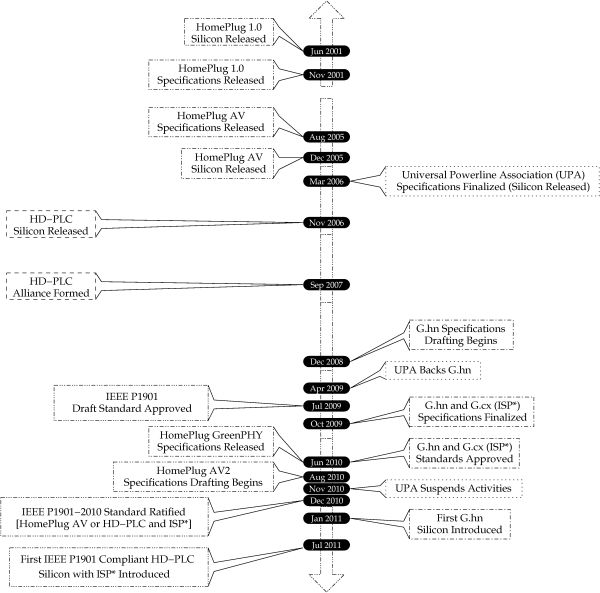G.hn Gains Momentum with Marvell Silicon
by Ganesh T S on September 27, 2011 3:01 AM EST- Posted in
- Powerline Adapters
- G.hn
- HomePlug
Irrespective of the technical capabilities of the products based on the two standards, it is essential that the adopted standard not disrupt existing installations of products based on other standards. This is especially important for MDUs (Multiple Dwelling Units), where the power lines are shared across multiple residences. One would definitely not want a G.hn device to mess up the operation of a HomePlug device. Considering that HomePlug already has an installed base, and there is no G.hn silicon with consumers yet, we believe that G.hn vendors must ensure that they peacefully coexist with them when it comes to the retail market. The G.9972 component of the standard specifies a coexistence mechanism for G.hn devices.
IEEE P1901 specifies a mandatory ISP (indicated with a star in the above timeline). This Inter-System-Protocol (also termed as Inter-Specification-Protocol in some documents) ensures that a IEEE P1901 device can coexist (with just loss in throughput) with a G.hn device. One must note that the G.hn device must also support the ISP (specified as G.cx). The chipset introduced by Marvell supports G.cx and it should be able to co-exist with IEEE P1901 devices implementing the ISP segment of the specification. In July 2011, Kawasaki Microelectronics (part of the HD-PLC alliance) introduced silicon compliant with IEEE P1901 and also implementing the ISP. Marvell indicated that the 88LX2142 could definitely coexist with such HD-PLC solutions. Note that coexistence implies absence of interference only. It doesn't mean that a UPA device can talk with a device based on G.hn silicon from Marvell.
In the above timeline, I have specifically refrained from indicating the availability of IEEE P1901 compliant HomePlug silicon (despite the fact that many chipsets such as the AR7400 from Qualcomm claim to be IEEE P1901 compliant). We have not found any documentation pointing to the existence of the mandatory ISP in it. (The AR7400 does support IPP (Inter-PHY-Protocol) which, at first glance, seems to enable them to co-exist with HD-PLC silicon). Note that the existence of ISP can be proved when it interoperates with a G.hn device, and G.hn devices are currently not in the market. Unless an interoperability / coexistence fest is organized with both IEEE 1901 silicon and G.hn silicon, this can't be completely proved or disproved.











11 Comments
View All Comments
glad2meetu - Thursday, September 29, 2011 - link
The G.hn solution offered by Marvell and other vendors will perform better in real life than most wireless N solutions. My neighbors all around me also have wireless N and G routers in their homes that results in interference. Most people have this problem unless they live in the countryside, in which case they likely will have issues just having access to a high speed ISP provider. The level of wireless interference is high in the 2.4GHz range. And 5GHz suffers from lower coverage, which is why it has always been a niche for wireless. The G.hn solution is much better for streaming applications to TVs and other home entertainment services. After all, every flat screen TV needs a plug for power and this plug or the coax that runs through most houses is quite suitable for heavy streaming video applications and does not need to be compressed. Telephone wires are similar, since DSL modems are nearly as common as cable modems. Full uncompressed 1080P and higher future video standards should be possible with G.hn. That is not feasible with wireless. The only pitfall for G.hn is wireless is nice for laptops and other stuff since you do not have a cord, which is good if you are just browsing the internet or running relatively light streaming applications.I expect we will start seeing people using both wireless and G.hn for their networking needs. Minimizing packet loss is something many people are willing to pay for with streaming applications, whether it is video or lan parties/online gaming. I predict there will be a significant market for this technology in the US. I expect G.hn may become one of the next new features in high end TVs after 3D. In many ways it reminds me of when SSD drives came out over the last couple of years relative to HDD drives in computer storage. Both SSD and HDD drives coexist in more computing systems these days. G.hn will coexist with wireless.
G.hn is simply more versatile than 1905.1. Nobody wants to have multiple different types of phy/macs and have to add network processors if you are a system provider since it adds to the cost to products. And 1905.1 is like the wireless B standard. Ultimately I don't see it as competitive with G.hn in terms of performance and reliability.